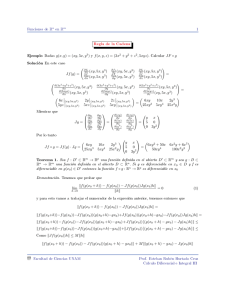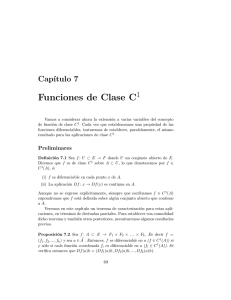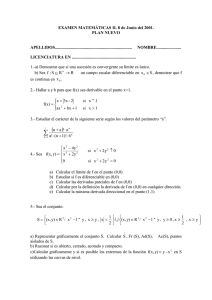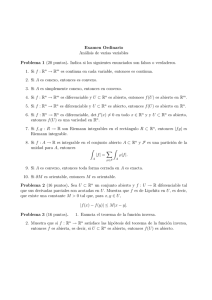Funciones de Rn en Rm 1 Diferenciales en Campos
Anuncio
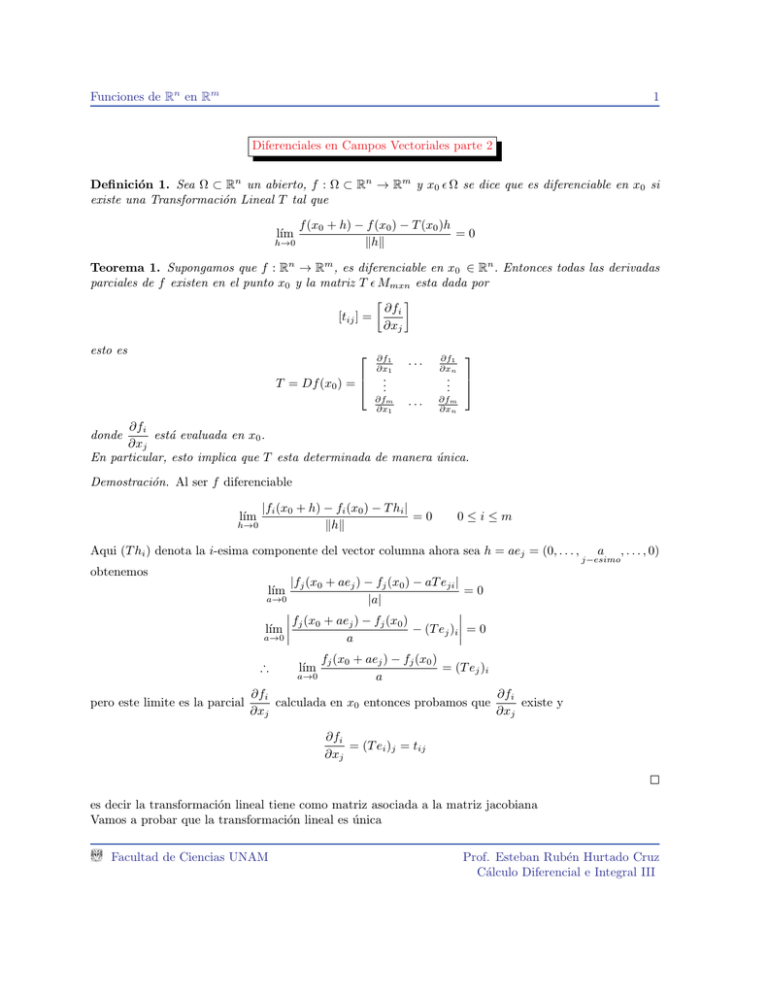
Funciones de Rn en Rm
1
Diferenciales en Campos Vectoriales parte 2
Definición 1. Sea Ω ⊂ Rn un abierto, f : Ω ⊂ Rn → Rm y x0 Ω se dice que es diferenciable en x0 si
existe una Transformación Lineal T tal que
lı́m
h→0
f (x0 + h) − f (x0 ) − T (x0 )h
=0
khk
Teorema 1. Supongamos que f : Rn → Rm , es diferenciable en x0 ∈ Rn . Entonces todas las derivadas
parciales de f existen en el punto x0 y la matriz T Mmxn esta dada por
∂fi
[tij ] =
∂xj
esto es
T = Df (x0 ) =
∂f1
∂x1
···
..
.
∂fm
∂x1
∂f1
∂xn
..
.
···
∂fm
∂xn
∂fi
está evaluada en x0 .
∂xj
En particular, esto implica que T esta determinada de manera única.
donde
Demostración. Al ser f diferenciable
lı́m
h→0
|fi (x0 + h) − fi (x0 ) − T hi |
=0
khk
0≤i≤m
Aqui (T hi ) denota la i-esima componente del vector columna ahora sea h = aej = (0, . . . ,
obtenemos
a
, . . . , 0)
j−esimo
|fj (x0 + aej ) − fj (x0 ) − aT eji |
=0
a→0
|a|
fj (x0 + aej ) − fj (x0 )
lı́m
− (T ej )i = 0
a→0 a
lı́m
∴
pero este limite es la parcial
lı́m
a→0
fj (x0 + aej ) − fj (x0 )
= (T ej )i
a
∂fi
∂fi
calculada en x0 entonces probamos que
existe y
∂xj
∂xj
∂fi
= (T ei )j = tij
∂xj
es decir la transformación lineal tiene como matriz asociada a la matriz jacobiana
Vamos a probar que la transformación lineal es única
Facultad de Ciencias UNAM
Prof. Esteban Rubén Hurtado Cruz
Cálculo Diferencial e Integral III
Funciones de Rn en Rm
2
Demostración. Supongamos que existieran transformaciones lineales T1 y T2 cumpliendo
lı́m
h→0
f (x0 + x) − f (x0 ) − T1 (x)
=0
khk
lı́m
h→0
f (x0 + x) − f (x0 ) − T2 (x)
=0
khk
entonces
f (x0 + x) − f (x0 ) − T1 (x)
−
h→0
khk
lı́m
f (x0 + x) − f (x0 ) − T2 (x)
khk
= lı́m
h→0
T2 (x) − T1 (x)
=0
khk
consideremos el siguiente cambio de variable h = tẋ donde t ∈ R y kẋk = 1 por lo tanto, tẋ → 0 cuando
h → 0 por lo tanto,
T2 (tẋ) − T1 (tẋ)
t[T2 (ẋ) − T1 (ẋ)]
lı́m
=
lı́m
t→0
T es lineal t→0
ktẋk
|t|kẋk
por lo tanto para cualquier t
T2 (ẋ) = T1 (ẋ)
∴
T2 = T1
Teorema 2. Sea Ω ⊂ Rn un abierto, f : Ω ⊂ Rn → Rm , x0 Ω. Si f es diferenciable en x0 , entonces f
es continua en x0 .
Demostración. Al ser f diferenciable en x0 se tiene que
lı́m
h→0
kf (x0 + h) − f (x0 ) − T (x0 )hk
=0
khk
en términos de δ
kf (x0 + h) − f (x0 ) − T (x0 )hk
<
khk
siempre que khk < δ
esto se puede escribir
kf (x0 + h) − f (x0 ) − T (x0 )hk < khk
siempre que khk < δ
por lo tanto tenemos que
kf (x0 + h) − f (x0 )k = kf (x0 + h) − f (x0 ) − T (x0 )h + T (x0 )hk ≤ kf (x0 + h) − f (x0 ) − T (x0 )hk + kT (x0 )hk
< khk + kT (x0 )hk
khk + M2 khk = khk( + M2 ) < δ( + M2 )
<
|{z}
T lineal⇒∃ M2 >0 tal que kT (x0 )hk<M2
Si hacemos 0 = δ( + M2 ) para 0 > 0 entonces δ =
0
( + M2 )
Por lo tanto
kf (x0 + h) − f (x0 )k < δ( + M2 ) =
0
( + M2 ) = 0
( + M2 )
y en consecuencia f es continua en x0
Facultad de Ciencias UNAM
Prof. Esteban Rubén Hurtado Cruz
Cálculo Diferencial e Integral III
Funciones de Rn en Rm
3
Teorema 3. Regla de la Cadena Sean g : Rn → Rm , f : Rm → Rp funciones dadas, entonces la
composición f ◦ g tiene la regla de correspondencia f (g(x)) y dominio
Domf ◦g = {x ∈ Domg | g(x) ∈ Domf }
Si g = (g1 , g2 , · · · , gm ) es diferenciable en un conjunto abierto D ⊂ Rn y f = (f1 , f2 , · · · , fp ) es diferenciable en en un conjunto abierto D0 tal que g(D) ⊂ D0 Entonces
J(f ◦ g) = Jf (g)Jg
Demostración. Tenemos que
∂f1
∂x1 (g1 , g2 , · · ·
Jf ◦ g =
∂f1 ∂g1
∂g1 ∂x1
∂fp ∂g1
∂g1 ∂x1
, gm )
···
..
.
∂fm
∂x1 (g1 , g2 , · · ·
+ ··· +
..
.
+ ··· +
∂f1
∂g1
···
..
.
∂fp
∂g1
Facultad de Ciencias UNAM
···
, gm ) · · ·
∂fp ∂gm
∂gm ∂x1
..
.
∂fp
∂gm
, gm )
..
.
∂f1 ∂gm
∂gm ∂x1
∂f1
∂gm
∂f1
∂xn (g1 , g2 , · · ·
···
∂fm
∂xn (g1 , g2 , · · ·
∂f1 ∂g1
∂g1 ∂xn
···
∂fp ∂g1
∂g1 ∂xn
∂g1
∂x1
···
..
.
∂gm
∂x1
+ ··· +
..
.
+ ··· +
∂g1
∂xn
..
.
···
∂gm
∂xn
=
, gm )
∂f1 ∂gm
∂gm ∂xn
∂fp ∂gm
∂gm ∂xn
=
= Jf (g)Jg
Prof. Esteban Rubén Hurtado Cruz
Cálculo Diferencial e Integral III
